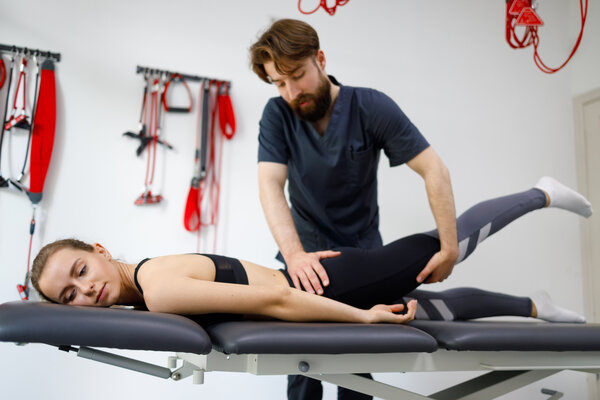Surgery can make a big difference in a person’s life. It can help to stop long-lasting pain or make your body work better. Whether it’s fixing a joint or some other kind of surgery, getting better can be tough.
But there’s something important that many people forget about physical therapy. In this article, we’ll talk about how physical therapy can improve your recovery after different surgeries.
It can help you move better and become more independent.
The Road To Recovery Begins With Physical Therapy
1. Optimizing Mobility
When you have surgery, one of the most important things is to move well afterward. After surgery, your body can get stiff, and your muscles can weaken because you haven’t moved much.
Physical therapy is about helping you move better, especially after surgeries like joint replacements or orthopedic procedures. Physical therapists have different ways to help you get your mobility back. They use exercises that can be passive or active.
Passive exercises mean the therapist gently moves your arms or legs for you, while active exercises mean you do the movements yourself, with just a little help. For example, if you’ve had knee surgery, the physical therapist might help you bend and straighten your knee to make it move better. And if you’ve had spinal surgery, they’ll have exercises to make your back more flexible and strengthen your core muscles.
Physical therapy helps you get back to moving without any pain by focusing on mobility. It’s like getting your freedom to move back!
2. Pain Management
When you have surgery, it can make you feel uncomfortable and in pain. This pain can make it tough to get better. But physical therapy is here to make it easier! Physical therapists have different ways to reduce pain and help you recover.
One of these ways is called manual therapy. This is when therapists gently use their hands to move your muscles and joints. It helps your blood flow, makes your muscles less tight, and removes the pain. It’s like a special touch that can make you feel better immediately!
Physical therapists can also use other cool things to help with pain. They might use heat or ice to soothe your body or special machines like ultrasound or electrical stimulation.
All these things work together to make sure you feel less pain and can focus on improving. So, say goodbye to pain!
3. Enhanced Recovery Timeline
Physical therapy can make you recover faster after surgery. With the help of experts and special exercises, you can get your strength and ability to move back quicker than if you tried on your own. This means you won’t have to feel uncomfortable for as long, lowering the chances of having problems because you couldn’t move much.
A faster recovery is helpful for people who want to return to their normal activities fast. Think about athletes – they want to start training and competing again soon. Also, people like construction workers or healthcare professionals who need to use their bodies for their jobs can benefit from getting better quickly so they can return to work sooner.
So, physical therapy isn’t just about feeling better; it’s about getting back to your regular life faster!
4. Customized Treatment Plans
When you have surgery, it’s important to remember that everyone is different. That’s why physical therapists create special treatment plans just for you. Whether you had knee surgery, a back operation, or something else, the therapy is made to help you get better in the best way possible.
It all starts with a thorough evaluation by the physical therapist. They check how you’re doing right now, what surgeries you’ve had before, and what you want to achieve with your recovery. After looking at all this, they make a plan that tells you exactly what exercises and techniques will help you get better. But here’s the cool part: the plan can change as you improve! If something unexpected happens or you start feeling stronger, the therapist can change the program to fit your progress. This means that the therapy always helps you in the best way, from start to finish. Your recovery journey is unique, just like you!
5. Functional Independence
The main goal of physical therapy after surgery is to help you be independent again. That means you can do everyday stuff independently, like walking, going upstairs, or reaching for things.
Physical therapists work hard to ensure you can have your regular life back. So, whether it’s playing with friends, going to school, or doing fun activities, physical therapy helps you get back to all of it. It’s like having a team of helpers to ensure you can enjoy your life just like before!
Case Studies: Real-Life Benefits
To understand how physical therapy can really make a difference after surgery, let’s check out two common situations: when people get new joints and when they have orthopedic surgery.
Case Study 1: Joint Replacement
Imagine you’ve just had a total hip replacement surgery because of really bad arthritis. Before the surgery, just walking or standing for a long time was super painful. But after the surgery, physical therapy becomes like your best friend in the journey to get better. Here’s how it helps:
- Pain Management: Your therapist has different ways to ensure you don’t hurt too much and that the swelling around your surgery spot goes down. This helps you begin your rehab faster.
- Getting You Moving Again: Your therapist gives you exercises just right for your hip. They start easy and get harder little by little. This helps your hip move better and strengthens the muscles around your hip.
- Walking Again: With the therapy you do regularly, you’ll be able to walk without needing help soon. This improves your life and lowers your chances of problems because you can’t move much.
- Regaining Independence: After some time and lots of hard work, you can do everyday stuff like getting dressed, cooking, and even doing the things you loved before surgery. Your hip feels better, you have less pain, and you can be more independent again. It’s like getting your life back!
Case Study 2: Orthopedic Surgery
Suppose you’ve undergone orthopedic surgery to repair a torn rotator cuff in your shoulder. The pain and limited range of motion before the surgery were frustrating. Here’s how physical therapy can make a difference:
- Customized Rehabilitation: Your therapist makes a special plan just for you. They think about your shoulder surgery and what you need to get better.
- Range of Motion: Your therapist helps your shoulder move better with exercises and stretches. This means you can use your arm fully again.
- Functional Recovery: As you keep doing therapy, you can do everyday stuff like reaching high, lifting things, and getting dressed without any pain or trouble.
- Returning to Work and Play: Because your therapy works so well, you can do regular stuff and go back to work and have fun doing things you love, like playing sports or gardening.
These stories show how physical therapy can help after different surgeries.
Whether it’s a joint replacement or orthopedic surgery, stopping pain, making you move better, and being independent are always important for a good recovery.
Patient Commitment And Continuity
To make physical therapy work well, you need to be committed. That means attending therapy sessions, doing the exercises they give you, and staying positive as you get better.
Here’s why it’s so important, with some important words to remember:
- Patient Commitment: That’s you! It would help if you were dedicated to getting better. This means attending all your therapy appointments, joining the exercises, and keeping a happy and hopeful attitude while you get better.
- Continuity of Care: This means your physical therapist is with you. They ensure you get the right care from start to finish and help you reach your goals.
So, remember, when you and your therapist work together, you have the best chance of getting better and feeling great again!
Conclusion
Physical therapy is like a guiding light that gives us hope and helps us make progress in the world of recovering after surgery.
It’s not just about getting our bodies moving again; it’s about getting our lives back. With special exercises, ways to manage pain, and plans made just for us, physical therapists help us become stronger and overcome the challenges of surgery.
Whether you’re getting a new joint or having another kind of surgery, remember that your physical therapist is like a trusted friend who helps you get back to moving well, feeling less pain, and living a good life.
So, when you take that first step without pain after surgery, remember to thank your physical therapist for being there and helping you reach that moment.



